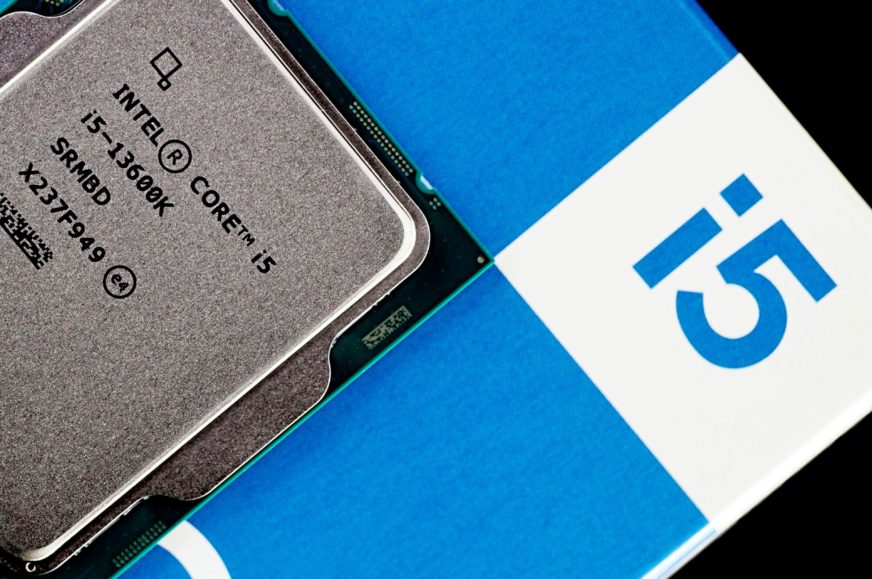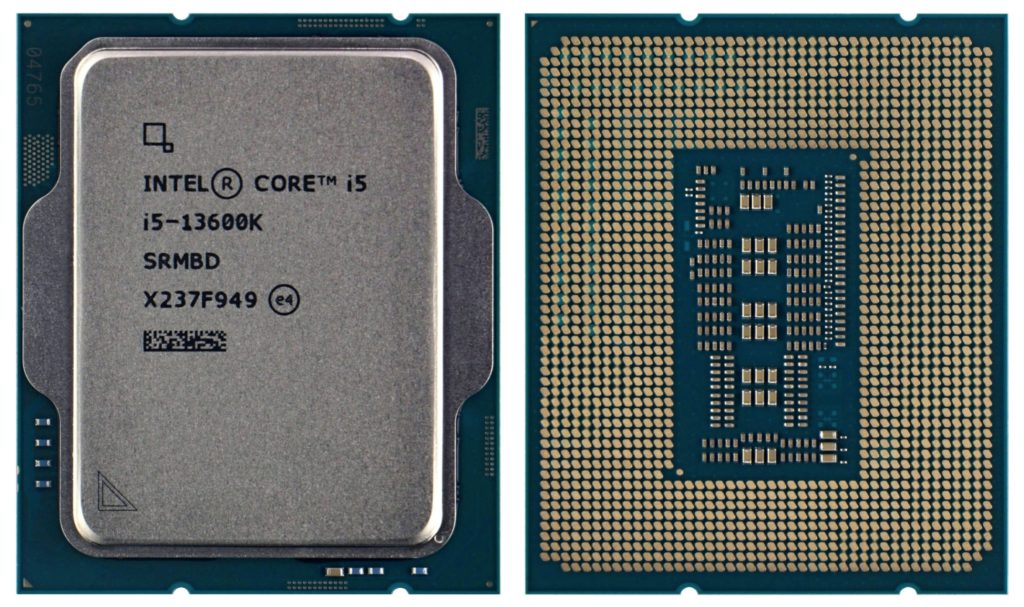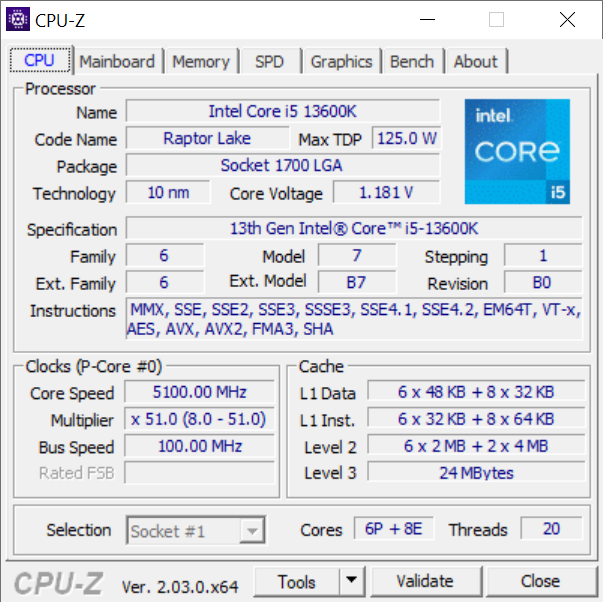Intel Core i5-13600K in detail
The Intel Core i5-13600K processor gives the impression of being from a slightly different class than the Ryzen 5 7600X. AMD’s Raphael with only 6 cores against 14 cores (albeit eight of them only small, Gracemont) of Raptor Lake may look like an underdog that should be significantly cheaper. However, one must be careful when making judgments. Although the Ci5-13600K is a great processor, so is the still only Ryzen 5 7000 in the game so far.
Intel Core i5-13600K in detail
Until the January release of the 65W TDP models, the Core i5-13600K is Intel’s cheapest and slowest Raptor Lake processor. Similar to the Core i9-13900K, the number of efficient (E) cores has been increased between generations. Instead of four (Ci5-12600K), there are up to eight, giving a total of 20 threads (six P cores with HyperThreading support plus eight E cores). This puts the Ci5-13600K ahead of even the Ryzen 7 7700X (8 cores/16 threads) in core and thread count, and the Ryzen 5 7600X looks a bit poor in this on paper.
Compared to the R5 7600X, the Core i5-13600K also has the advantage of a dual controller and support for not only DDR5 memory (like AMD’s Ryzen 7000 processors), but also the older and cheaper DDR4 standard. The latter is primarily cheaper (although the price difference is already significantly less than it was a year ago), which from the perspective of the entire platform becomes especially evident in the price/performance ratio for lower-end processor models. DDR4 memory is otherwise supported by all Intel Raptor Lake processors (including the Core i9-13900K).
Motherboards with DDR4 memory support are also a bit cheaper (than for AMD processors) for Core i5-13600K. However, it should be taken into account that Ryzen 5 7600X is cheaper than Core i5-13600K by at least 20 EUR and the difference between the prices of similarly equipped computers across platforms is not as dramatic as it is sometimes portrayed.
The Core i5-13600K enters this duel (with the Ryzen 5 7600X) with core count superiority, but it only supports Turbo Boost 2.0. The achieved single-core boost frequencies are 700 MHz lower than those of the Core i9-13900K, so in single-threaded performance, the Ci5-13600K will lose significantly more to the Core i9 than the Ryzen 5 7600X loses to the Ryzen 9s.
The Core i5-13600K’s power limit for short-term load (PL2) is 72 W lower (181 W) than in the Core i9-13900K, but there is a 31 W increase over the Ci5-12600K. The TDP is the same across all “K” processors (from this and past generations, up to Comet Lake) at 125 W.
The Core i5-13600K chip is the same as the Core i9-13900K, with a die area of approximately 257 mm², except that it is partially disabled. Lower clocked, but otherwise the same as in the Ci9-13900K is also the UHD 770 iGPU with 32 blocks of compute units (CUs).
| Manufacturer | Intel | AMD | |
| Line | Core i5 | Ryzen 5 | |
| SKU | 13600K | 7600X | |
| Codename | Raptor Lake | Raphael | |
| CPU microarchitecture | Golden Cove (P) + Gracemont (E) | Zen 4 | |
| Manufacturing node | 7 nm („Intel 7 Ultra“) | 5 nm + 6 nm | |
| Socket | LGA 1700 | AM5 | |
| Launch date | 10/20/2022 | 09/26/2022 | |
| Launch price | 319 USD | 299 USD | |
| Core count | 6+8 | 6 | |
| Thread count | 20 | 12 | |
| Base frequency | 3.5 GHz (P)/2.6 GHz (E) | 4.7 GHz | |
| Max. Boost (1 core) | 5.1 GHz (P)/3.9 GHz (E) | 5.3 GHz (5.45 GHz unofficially) | |
| Max. boost (all-core) | 5.1 GHz (P)/3.9 GHz (E) | N/A | |
| Typ boostu | TB 2.0 | PB 2.0 | |
| L1i cache | 32 kB/core (P), 64 kB/core (E) | 32 kB/core | |
| L1d cache | 48 kB/core (P), 32 kB/core (E) | 32 kB/core | |
| L2 cache | 2 MB/core (P), 4× 4 MB/4 cores (E) | 1 MB/core | |
| L3 cache | 1× 24 MB | 1× 32 MB | |
| TDP | 125 W | 105 W | |
| Max. power draw during boost | 181 W (PL2) | 142 W (PPT) | |
| Overclocking support | Yes | Yes | |
| Memory (RAM) support | DDR5-5600/DDR4-3200 | DDR5-5200 | |
| Memory channel count | 2× 64 bit | 2× 64 bit | |
| RAM bandwidth | 89.6 GB/s/51.2 GB/s | 83,2 GB/s | |
| ECC RAM support | Yes (with vPro/W680) | Yes (depends on motherboard support) | |
| PCI Express support | 5.0/4.0 | 5.0 | |
| PCI Express lanes | ×16 (5.0) + ×4 (4.0) | ×16 + ×4 + ×4 | |
| Chipset downlink | DMI 4.0 ×8 | PCIe 4.0 ×4 | |
| Chipset downlink bandwidth | 16.0 GB/s duplex | 8.0 GB/s duplex | |
| BCLK | 100 MHz | 100 MHz | |
| Die size | ~257 mm² | 66,3 mm² + 118 mm² | |
| Transistor count | ? bn. | 6,57 + 3,37 bn. | |
| TIM used under IHS | Solder | Solder | |
| Boxed cooler in package | No | No | |
| Instruction set extensions | SSE4.2, AVX2, FMA, SHA, VNNI (256-bit), GNA 3.0, VAES (256-bit), vPro | SSE4.2, AVX2, FMA, SHA, VAES (256-bit), AVX-512, VNNI | |
| Virtualization | VT-x, VT-d, EPT | AMD-V, IOMMU, NPT | |
| Integrated GPU | UHD 770 | AMD Radeon | |
| GPU architecture | Xe LP (Gen. 12) | RDNA 2 | |
| GPU: shader count | 256 | 128 | |
| GPU: TMU count | 16 | 8 | |
| GPU: ROP count | 8 | 4 | |
| GPU frequency | 300–1500 MHz | 400–2200 MHz | |
| Display outputs | DP 1.4a, HDMI 2.1 | DP 2.0, HDMI 2.1 | |
| Max. resolution | 7680 × 4320 (60 Hz) | TBD | |
| HW video encode | HEVC, VP9 | HEVC, VP9 | |
| HW video decode | AV1, HEVC, VP9 | AV1, HEVC, VP9 |
- Contents
- Intel Core i5-13600K in detail
- Methodology: performance tests
- Methodology: how we measure power draw
- Methodology: temperature and clock speed tests
- Test setup
- 3DMark
- Assassin’s Creed: Valhalla
- Borderlands 3
- Counter-Strike: GO
- Cyberpunk 2077
- DOOM Eternal
- F1 2020
- Metro Exodus
- Microsoft Flight Simulator
- Shadow of the Tomb Raider
- Total War Saga: Troy
- Overall gaming performance
- Gaming performance per euro
- PCMark and Geekbench
- Web performance
- 3D rendering: Cinebench, Blender, ...
- Video 1/2: Adobe Premiere Pro
- Video 2/2: DaVinci Resolve Studio
- Graphics effects: Adobe After Effects
- Video encoding
- Audio encoding
- Broadcasting (OBS and Xsplit)
- Photos 1/2: Adobe Photoshop and Lightroom
- Photos 2/2: Affinity Photo, Topaz Labs AI Apps, ZPS X, ...
- (De)compression
- (De)encryption
- Numerical computing
- Simulations
- Memory and cache tests
- Processor power draw curve
- Average processor power draw
- Performance per watt
- Achieved CPU clock speed
- CPU temperature
- Conclusion













